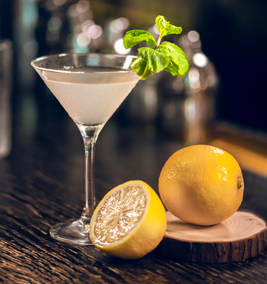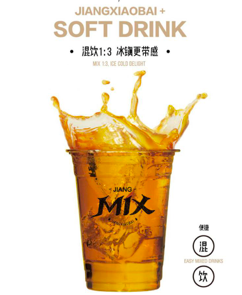Lifestyle
Are Baijiu Cocktails the Next Trend?

The base liquor in a cocktail is essential for its character and style. Currently there are six main spirits that dominate the world of bartending. Those are gin, rum, whisky, vodka, brandy and tequila. However, in our fast-paced world of ever-changing circumstance, there has been a new spirit on the rise. Chinese baijiu is becoming a more viable option for many bartenders, since baijiu manufacturers started targeting the international market. Some scene bars already feature baijiu cocktails on their menu.
Unfortunately, the spirit category with the world’s highest sales numbers has a somewhat antiquated image. The associated consumer group is typically middle-aged to older people. The characteristic aroma of Chinese baijiu is its trademark, but the strong pungency also limits the range of consumption scenarios–as for mixing. Some traditional liquor brands have tried to rejuvenate baijiu, hoping to open the market of young people. However, the acceptance in that market segment is still comparably low. Priming baijiu as a base for cocktails, could bring the turning point in perception.
In recent years, more and more baijius with light flavor have come out. This is due to the international demand, as well as the increased effort and innovation in development of blending techniques. JIANGXIAOBAI is a typical enterprise adept at producing innovative mild flavor baijius. With these new products coming to the market, the mixology scene has one more tile to play with in their creations.
Here are some ways to enjoy your mixed drink with baijiu:
Lowering the degree of alcohol, Sprite or coke make great mixers for light-aroma baijiu. As with whiskies, one could use a drop of water to activate the aroma compounds of baijiu. Or you could cover a plum with boiling water, add ice to cool the mix down and then add the plum to your favorite baijiu. If you like a strong taste, you can add 4 liters of water to half a bottle of baijiu. Down below, find some tasty cocktails with baijiu as a base:
- Starlight at Midnight
30 ml light-aroma baijiu
1 small bag of Pop Rocks candy
100 ml cola
Method: Add 4 cubes of ice into highball, pour baijiu and cola in turns. Stir, then add Pop Rocks into glass. Finally, add straw for better drinking experience.
Profile: Sweet, refreshing and tasty. Hear the sound of the Pop Rocks while drinking.
- Shanghai Nights
30 ml light-aroma baijiu
10 ml lemon juice
120 ml cola
1 slice of lemon
Method: Add two ice cubes to the glass and pour the lemon juice. Stir, then fill with cola. Decorate with lemon slice.
Profile: Long drink for a chill evening chat with your friends.
- Red Sorghum
15 ml light-aroma baijiu
40 ml dry red wine
1 piece of lemon peel or orange peel
Method: Add four ice cubes to the mixing glass. Pour baijiu and dry red wine in turn. Stir for a while, then strain into cocktail glass. Add one piece of lemon peel or orange peel.
Profile: This cocktail is dry and appealingly fragrant.

Baijiu cocktails might still be flying under the radar, but if you like trying new things, don’t hesitate to ask your local bartender for a new mix.
JIANGXIAOBAI is one of the pioneers in baijiu cocktails. Its J-Mix project has been specifically launched to create innovative new mixed drinks and involve the world of bartenders with baijiu. This year, the producer of sorghum spirits provided the official liquor for the IBA (International Bartenders Association) competition.
For more information, please visit: https://www.jiangjidistillery.com/
Lifestyle
The Missing Piece in Self-Help? Why This Book is Changing the Wellness Game

Self-help shelves are full of advice — some of it helpful, some of it recycled, and most of it focused on “mindset.” But Rebecca Kase, LCSW and founder of the Trauma Therapist Institute, is offering something different: a science-backed, body-first approach that explains why so many people feel struck, overwhelmed, or burned out — and what they can actually do about it.
A seasoned therapist and business leader, Kase has spent nearly two decades teaching others how to navigate life through the lens of the nervous system. Her newest book, “The Polyvagal Solution,” set to release in May 2025, aims to shake up the wellness space by shifting the focus away from willpower and onto biology. If success has felt out of reach — or if healing has always seemed like a vague concept — this book may be the missing link.
A new way to understand stress and healing
At the heart of Kase’s approach is polyvagal theory, a neuroscience-based framework that helps explain how our bodies respond to safety and threat. Developed by Dr. Stephen Porges, polyvagal theory has transformed the way many therapists understand trauma, but Kase is bringing this knowledge to a much wider audience.
“The body always tells the truth,” Kase says. “If you’re anxious, exhausted, or always in overdrive, your nervous system is asking for support, not more discipline.”
“The Polyvagal Solution” makes this complex theory digestible and actionable. Instead of promising quick fixes, Kase offers strategies for regulating the nervous system over time, including breathwork, movement, boundaries, and daily practices that better align with how the human body functions. It’s less about pushing through discomfort and more about learning to tune in to what the body needs.
From clinical expertise to business insight
What sets Kase apart isn’t just her deep understanding of trauma but how she blends that knowledge with real-world experience as a business owner and leader. As the founder of the Trauma Therapist Institute, she scaled her work into a thriving company, all while staying rooted in the values she teaches.
Kase has coached therapists, executives, and entrepreneurs who struggle with burnout, anxiety, or feeling disconnected from their work. Regardless of who she works with, though, her message remains consistent: the problem isn’t always mindset — it’s often regulation.
“Success that drains you isn’t success. It’s survival mode in disguise,” Kase explains. Her coaching programs go beyond traditional leadership training by teaching high achievers how to calm their nervous systems, enabling them to lead from a grounded place, not just grit.
Making the science personal
For all her clinical knowledge, Kase keeps things human. Her work doesn’t sound like a lecture but rather like a conversation with someone who gets it. That’s because she’s been through it herself: the long hours as a therapist, the emotional toll of supporting others, the realities of building a business while managing her own well-being.
That lived experience informs everything she does. Whether she’s speaking on stage, running a retreat, or sharing an anecdote on her podcast, Kase has a way of weaving humor and honesty into even the heaviest topics. Her ability to balance evidence-based practice with practical advice is part of what makes her voice so compelling.
Kase’s previous book, “Polyvagal-Informed EMDR,” earned respect from clinicians across the country. But “The Polyvagal Solution” reaches beyond the therapy community to anyone ready to understand how their body is shaping their behavior and how to create real, sustainable change.
Why this message matters
We’re in a moment where burnout is common and overwhelm feels normal. People are looking for answers, but many of the tools out there don’t address the deeper cause of those feelings.
That’s where Kase’s work lands differently. Instead of telling people to “think positive” or “try harder,” she teaches them how to regulate their own biology. And in doing so, she opens the door for deeper connection, better decision-making, and more energy for the things that matter.
As more workplaces begin to embrace trauma-informed leadership, more individuals are seeking solutions that go beyond talk therapy and motivational content. Kase meets that need with clarity, compassion, and a toolkit rooted in both science and humanity.
A grounded approach to lasting change
What makes “The Polyvagal Solution” stand out is its realism. It doesn’t ask readers to overhaul their lives but instead asks them to listen — to pay attention to how their bodies feel, how their stress patterns manifest, and how even small shifts in awareness can lead to significant results over time. Whether you’re a therapist, a team leader, or someone trying to feel more at ease in your own skin, this book offers a way forward that feels both grounded and achievable.
Rebecca Kase isn’t just adding another title to the self-help genre. She’s redefining it by reminding us that we don’t have to muscle our way through life. We just have to learn how to work with, not against, ourselves.
And maybe that’s the real game-changer we’ve been waiting for.
-

 Tech4 years ago
Tech4 years agoEffuel Reviews (2021) – Effuel ECO OBD2 Saves Fuel, and Reduce Gas Cost? Effuel Customer Reviews
-

 Tech6 years ago
Tech6 years agoBosch Power Tools India Launches ‘Cordless Matlab Bosch’ Campaign to Demonstrate the Power of Cordless
-

 Lifestyle6 years ago
Lifestyle6 years agoCatholic Cases App brings Church’s Moral Teachings to Androids and iPhones
-

 Lifestyle4 years ago
Lifestyle4 years agoEast Side Hype x Billionaire Boys Club. Hottest New Streetwear Releases in Utah.
-

 Tech7 years ago
Tech7 years agoCloud Buyers & Investors to Profit in the Future
-

 Lifestyle5 years ago
Lifestyle5 years agoThe Midas of Cosmetic Dermatology: Dr. Simon Ourian
-

 Health6 years ago
Health6 years agoCBDistillery Review: Is it a scam?
-

 Entertainment6 years ago
Entertainment6 years agoAvengers Endgame now Available on 123Movies for Download & Streaming for Free
